
How do you make a good movie about someone who sleeps all the time? Well, Disney sure did. 1959's Sleeping Beauty remains one of their greatest films. It's kind of miraculous, being such a strange confluence of influences and vision. The marked elegance of Eyvind Earle's modernist backgrounds is oddly contrasted with the buffoonery of the three good fairies; often the film gives the impression of children playing in an abandoned cathedral. The contrast of hot and cold works out marvellously, though, each extreme emphasising the beauty of the other. In terms of writing, Sleeping Beauty offers the most distant of the Disney Princesses--she only has two scenes of dialogue--and many of the radical changes wrought from Charles Perrault's 17th century version leave dangling threads of thematic suggestion that make little sense in a story that's ultimately about parenthood. But it mostly works and it's capped off, surprisingly, by one of the great action sequences in cinema history.
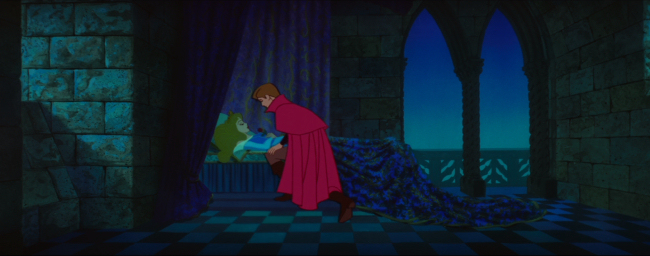
The standard complaint about Disney Princesses is that they marry guys they barely know--it's such an old criticism that by the time Frozen included a whole subplot lampooning the tradition the criticism itself already felt well aged. Yet in the 17th century story, the prince does not wake the princess by kissing her. He kneels beside her and then they talk for four hours before he goes home. No mention of him even touching her. Time passes and they develop a relationship and have kids.
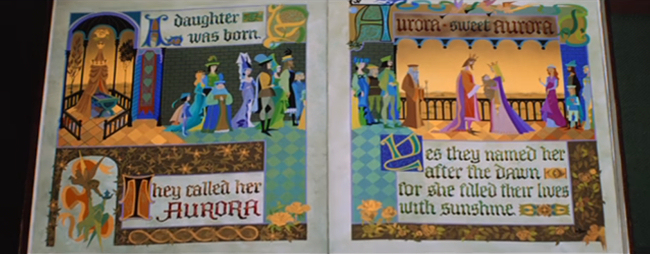
One of the most brilliant features of Disney's film is its use of music from Tchaikovsky's 1889 ballet. The prince awakens the princess by kissing her in that version but, in a ballet, with no dialogue, where the actions of the performers may be taken as symbolic of different kinds of chemistry and relationships, a kiss doesn't seem like such a strange first move. Perhaps it was in thinking it strange that Disney accidentally made things stranger. In the film version, the princess, called Aurora (Mary Costa), meets the prince in the forest hours before she falls under her cursed sleep. The reasons for this seem obvious--the stakes would be higher and more personal if the prince actually knows and loves the princess already when he goes to rescue her. But instead of making it a more conventional relationship it becomes something a bit weirder.

Aurora doesn't get much time to establish her character but the animators, drawing from reference model Helene Stanley, do a pretty good job in a small space bringing life and warmth to her physical mannerisms. The scene begins with light comedy as she fantasies about meeting the man of her dreams with her forest animal friends. The Disney Princesses are almost always friends with forest animals--it thematically ties them to nature and also allows them to role play as mothers. Then, she actually meets the man of her dreams.

And I love it. Your mileage may vary but the magic really works for me. The strange, cube shaped foliage in the background and the hard edged cliffs from Eyvind Earle emphasise the weirdness and dreamlike quality of the space while the naturalism of the animation helps bring warmth to it. And why shouldn't something that starts as a joke turn beautiful and sweet?

But the filmmakers are well aware of how unwise it is for teenagers to rush into a relationship, even though their own changes to the source material brought it about. Prince Phillip (Bill Shirley), who also doesn't get a lot of dialogue, goes home to his father and tells him about the love of his life he met that afternoon. His father, King Hubert (Bill Thompson) is aghast. Shortly beforehand, King Stefan (Taylor Holmes), had gently suggested it might be a shock to Aurora that she might have to marry a guy shortly after meeting him. There's a recurrent theme in this movie about deliberately bringing about a reality based on a vision--Aurora creates a romance based on her dream, the Kings dream of a united kingdom through the marriage of their children, and story's main events are set in motion by the fairies making prophecies of Aurora's life. Turns out there's a lot of wiggle room for spontaneous action, though.

Older people having dreams for the younger people is one of the things that makes this movie about parenting. The real protagonists of the film are Flora (Verna Felton), Fauna (Barbara Jo Allen), and Merryweather (Barbara Luddy). They're the ones who hatch the plan to raise Aurora in secret and we watch them carry it out. They have that great comedy sequence where they try to cook and make a dress without magic, then they steer events at the castle after Maleficent (Eleanor Audley) succeeds in getting Aurora to prick her finger. They rescue Phillip and give him a sword and shield and even when Phillip deals the decisive blow Flora adds an additional enchantment. They have the most screen time and the most dialogue. Friendly, silly, and maternal, naturally they would be the characters children would feel the most comfortable with.
It's another striking difference from the Perrault story which seems to sympathise with the young in a conflict against the old. The fairy that curses the princess is described as old while the one who changes the curse from death to sleep is described as young. Merryweather might be younger than Flora and Fauna but it's difficult to tell whether she or Maleficent is the elder. In Perrault's version, the prince has to conceal his romance with the princess from his mother who turns out to be an ogre, a really fascinating detail. There's a suggestion that the mother has an internal struggle over whether to be more like a human or an ogre but the ogre half wins after she learns about her son's secret marriage. A famous aspect of the story is the princess' hundred year sleep. It also appears that the prince's parents rule over the same kingdom and although the princess is young she also represents an earlier era before ogre blood got into the family. Considering European views on royal bloodlines in the 17th century, this could've been a pretty obvious political allegory.
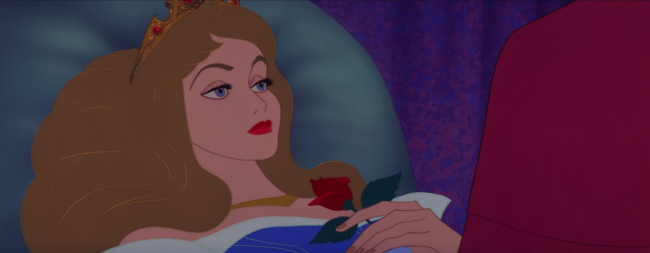
There's a sweetness in the idea that the rebellious dreams of youth end up being essentially the same as the wishes of their elders, that the man Aurora meets in the woods also happens to be the man she's betrothed to. I like the idea of the parents being outraged when they fail to recognise their own dream in another form in their children. And I love the symbolism of Merryweather and Flora fighting over the colour of Aurora's dress so that, even as the film ends, her dress is still magically changing from pink to blue and back again. So conflicting wishes of two parents for a child can and often do remain in play throughout the child's entire life so that the child becomes adept at being able to switch from the appearance of one to the other--the magical thing being not that either dream takes hold but that she has a dress that constantly changes colour.
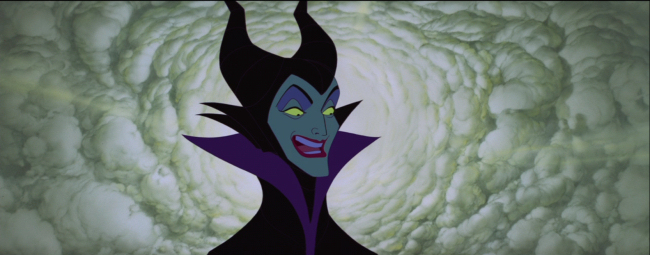
There's also the bad parent, Maleficent, the one whose design for the child is completely motivated by her desire to take revenge on the other parents and on the world. Of course, there are indeed parents like this. And what a great villain she is--combining the best of what came before--a bit of Snow White's evil queen, a bit of the "Night on Bald Mountain" demon, even a little bit of the Headless Horseman. The final sequence in terms of music, editing, and composition is full of excitement and exquisite nightmare imagery.

I love how she hurls herself from one castle to another in what looks like a flying sparkler before her transformation into a dragon is effected through minutely animated smoke curls. Actress Eleanor Audley deserves a lot of credit, too, she squeezes every last drop of sinister from every line and hits that climactic challenge, "Now shall you deal with me, oh Prince, and all the powers of Hell!" like the very Devil. She's also brilliant delivering a prophecy to Phillip when he's in her dungeon that's just deliciously sadistic, sarcastically describing him riding forth, straight and tall, while showing him bent and old.
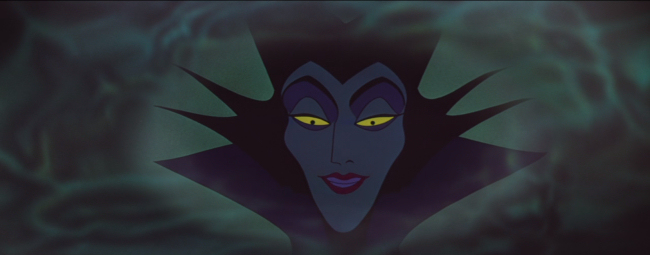
I always find it curious that Maleficent is able to knock away the "Shield of Virtue" before Phillip kills her with the "Sword of Truth". Was this intentional symbolism? That truth will inevitably prevail while prescribed virtue is but a temporary defense, a "mere scutcheon", as Falstaff would say? I don't know. But I love this movie in any case.
Twitter Sonnet #1396
Consistent thoughts denied the human space.
A warping floor delivers drops of mad.
By cars, the hobby horses kept apace.
With metal feet we land upon the pad.
A challenge spoke in flattened pixel sparks.
Exported tops encounter bottom hulls.
A single goose commands a fleet of arks.
A dozen horns deform a pair of bulls.
Another try produced a jacket moth.
We really thought the twisty tie would hold.
The gummy clouds were broke and sort of goth.
A name is like a shiny hat but old.
A cable carried lunch to tiny towns.
The creamy coffee's sweet in varied browns.

No comments:
Post a Comment